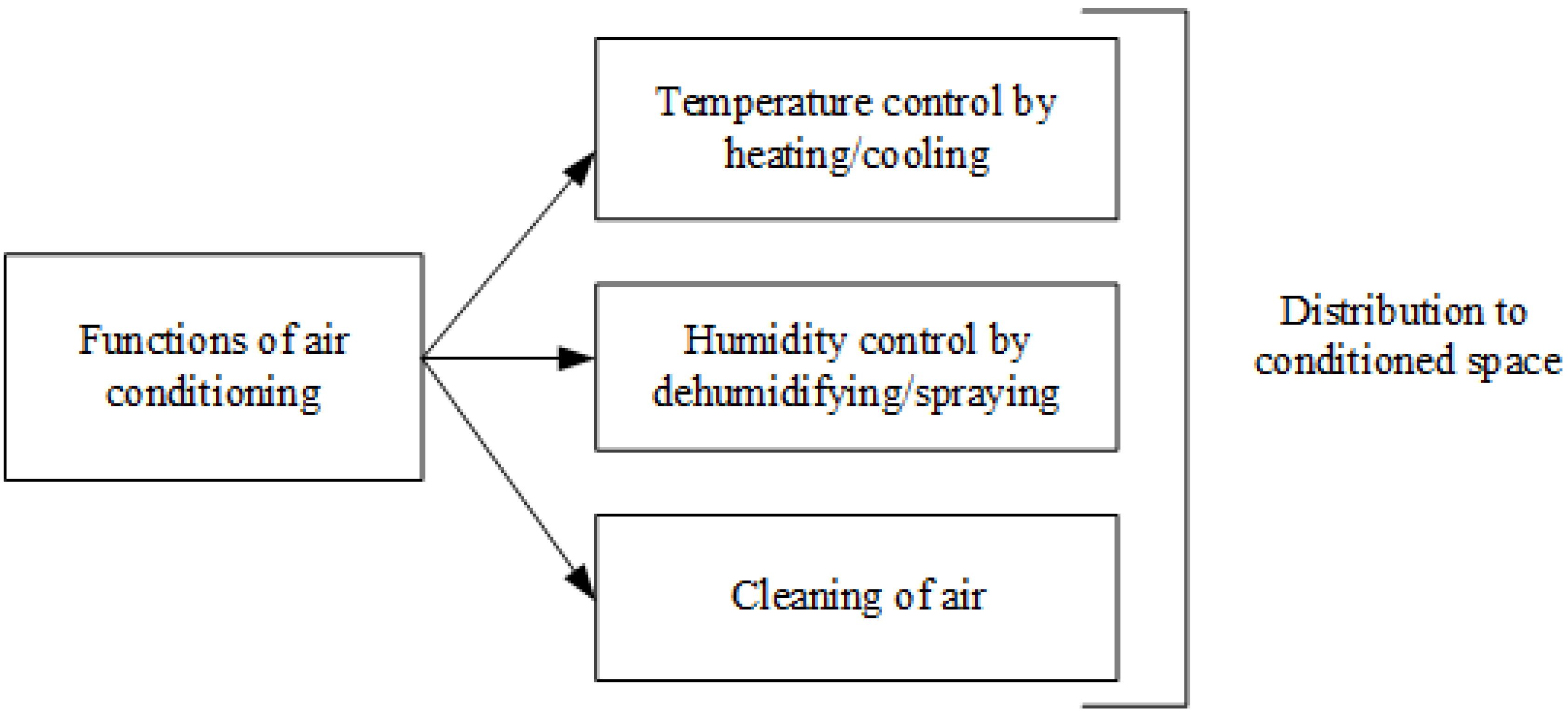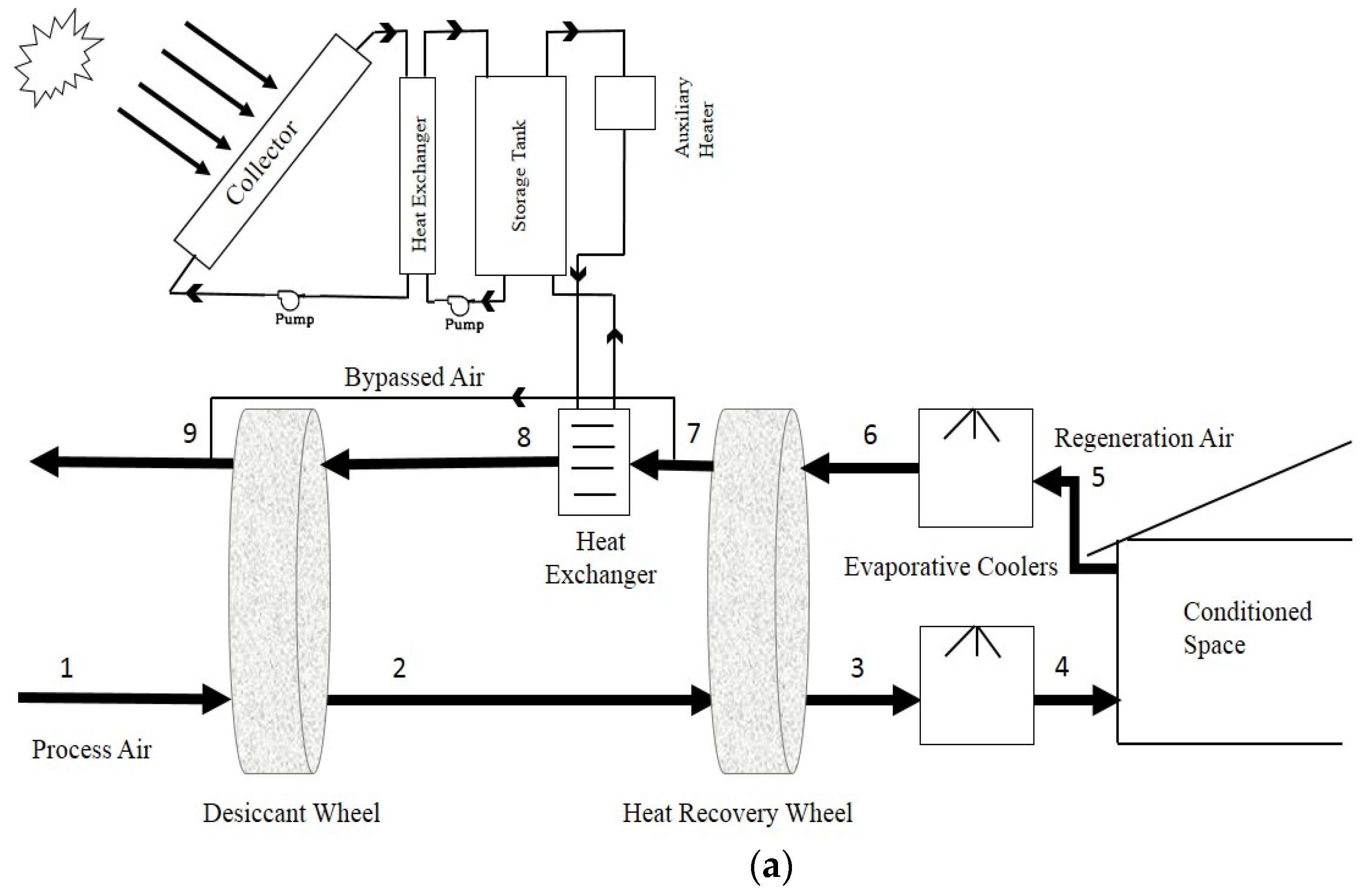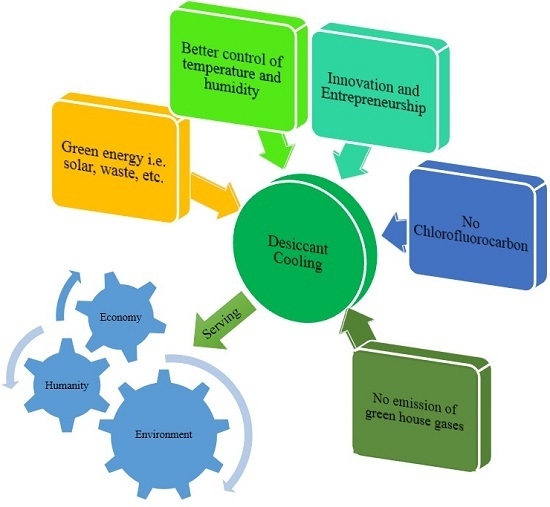Analysis of a Solar Cooling System for Climatic Conditions of Five Different Cities of Saudi Arabia
Abstract
:1. Introduction
- The most recent standards regarding environmental comfort and indoor air quality (IAQ) impose restrictive limits to indoor relative humidity values.
- Chlorofluorocarbon (CFC) and Hydro Chlorofluorocarbon (HCFC) refrigerant fluids are expected to disappear.
- Electric power peaks need to be reduced.

| Parameter | Central Air Conditioning System | Desiccant Dehumidification System |
|---|---|---|
| Cost of Operation | High | Saves about 40% |
| Driving Source of Energy | Electricity, Natural gas | Low grade energy e.g., solar energy, waste heat, etc. |
| Humidity Control | Average | Accurate |
| Quality of Indoor Air | Average | Good |
| System Installment | Easy and well-known | Slightly complicated |
| Capacity for Storage of Energy | Average | Good |
Need of Alternative Energy Systems in Saudi Arabia

| Parameter | Amount/Value |
|---|---|
| Energy Use Per Capita | 6738.42 kg of oil equivalent |
| Population | 27.76 million |
| CO2 Emissions Per Capita | 17.04 metric tons |


2. Solid Desiccant Based Evaporative Cooling System
2.1. System Description


2.2. Solar Collector Subsystem
2.3. Solar Fraction
3. Performance Parameters
4. Results and Discussion
| Location | Jeddah | Jazan | Riyadh | Hail | Dhahran |
|---|---|---|---|---|---|
| Latitudes (ø) | 21.7 | 16.9 | 24.7 | 27.4 | 26.3 |
| Longitude | 39.2 | 42.6 | 46.7 | 41.7 | 50.2 |
| Elevation (m) | 17 | 7 | 620 | 1002 | 17 |
| Wind speed (m/s) | 3.6 | 3.3 | 0.5 | 3.2 | 4.4 |
| Name of Cities | Outdoor Air | Supply Air | COP (Treg = 120 °C) | ||||
|---|---|---|---|---|---|---|---|
| Dry Bulb Temperature (°C) | Wet Bulb Temperature (°C) | Specific Humidity (g/kg) | Dry Bulb Temperature (°C) | Wet Bulb Temperature (°C) | Specific Humidity (g/kg) | ||
| Jeddah | 32.7 | 24.8 | 16.76 | 19.85 | 16.05 | 10.30 | 0.447 |
| Jazan | 33.6 | 26.93 | 20.06 | 20.33 | 18.55 | 11.42 | 0.476 |
| Riyadh | 34.8 | 25.13 | 19.50 | 19.80 | 17.90 | 10.43 | 0.387 |
| Hail | 32.6 | 22.23 | 15.93 | 18.33 | 16.42 | 9.46 | 0.275 |
| Dhahran | 36.1 | 26.53 | 18.29 | 21.77 | 18.22 | 10.22 | 0.463 |





5. Conclusions
- It has been found that the effective control of dehumidification capacity can be achieved by using desiccant based evaporative cooling systems in hot and humid climatic conditions.
- For Jazan, the potential of the proposed system is found to be high to provide the thermal comfort conditions compared to other cities.
- It has also been observed that an increase of 15% in evaporative cooler effectiveness resulted in about 15%–25% increase in COP of the system depending on the location.
- An increase in regeneration temperature and ratio of air flow rate caused a decrease in the system COP.
- The effectiveness of the desiccant wheel increases with the increase in ambient air humidity ratio.
- Furthermore, the results showed that moisture removal rate is the maximum for the climatic conditions of Jazan.
- Among all five cities, Jazan was found to have the maximum solar energy potential for the whole year while Riyadh has the minimum.
- The lower value of regeneration temperature is beneficial for the performance of the system, as it defines the required input energy.
Acknowledgments
Author Contributions
Conflicts of Interest
Nomenclatures
| EFan | fan electrical power (kW) |
| h | specific enthalpy (kJ/kg) |
| M | moisture removal rate (g/s) |
mass flow rate (kg/s) | |
mass flow rate of water (kg/s) | |
| Qc | cooling load (kW) |
| Qr | regeneration heat (kW) |
| Treg | regeneration temperature (°C) |
Greek Letters
| ω | humidity ratio (g/kg) |
| ε | effectiveness (-) |
Subscripts
| a | Ambient |
| DW | desiccant wheel |
| DCS | desiccant cooling system |
| H | Heater |
| HRW | heat recovery wheel |
| EC | evaporative cooler |
| p | Process |
| r | Regeneration |
| v | Vapor |
References
- Ameen, A. The challenges of air-conditioning in Tropical and Humid Tropical climates. In Proceedings of the International Conference on Mechanical Engineering (ICME 2005), Dhaka, Bangladesh, 28–30 December 2005.
- Rafique, M.M. A statistical analysis of desiccant dehumidifier for air conditioning application. Int. J. Hybrid Inf. Technol. 2015, 8, 245–256. [Google Scholar] [CrossRef]
- Meckler, M. Desiccant-assisted air conditioner improves IAQ and comfort. Heat. Pip. Air Cond. 1994, 66, 75–84. [Google Scholar]
- McGahey, K. New commercial applications for desiccant-based cooling. ASHRAE J. 1998, 40, 41–45. [Google Scholar]
- Gagliano, A.; Patania, F.; Nocera, F.; Galesi, A. Performance assessment of a solar assisted desiccant cooling system. Therm. Sci. 2014, 18, 563–576. [Google Scholar] [CrossRef]
- Stefano, E.; Tiberi, V. Dimensioning and efficiency evaluation of hybrid solar systems for energy production. Therm. Sci. 2008, 12, 127–138. [Google Scholar]
- Angrisani, G.; Roselli, C.; Sasso, M.; Tariello, F. Assessment of energy, environmental and economic performance of a solar desiccant cooling system with different collector types. Energies 2014, 7, 6741–6764. [Google Scholar] [CrossRef]
- Bulck, E. The Design of Dehumidifiers for Use in Desiccant Cooling and Dehumidification Systems, Desiccant Cooling and Dehumidification; ASHRAE: Atlanta, GA, USA, 1992; pp. 118–126. [Google Scholar]
- Pesaran, A.A.; Penney, T.R.; Czanderna, A.W. Desiccant Cooling: State-of-the-Art Assessment; Technical Report No. NREL/TP-254-4147; National Renewable Energy Laboratory: Golden, CO, USA, 1992. [Google Scholar]
- Shipman, B.C. Air Cooling and Conditioning Apparatus and System. U.S. Patent 2,058,042, 10 April 1936. [Google Scholar]
- Fleisher, W.L. Adsorption System of Air Conditioning. U.S. Patent 2,147,248, 14 February 1939. [Google Scholar]
- Larriva, G.A. Air Conditioning System and Apparatus Therefor. U.S. Patent 4,612,019, 16 December 1941. [Google Scholar]
- Altenkirch, E. Separating and Cooling Apparatus. U.S. Patent 2,233,189, 25 February 1941. [Google Scholar]
- Altenkirch, E. Air Conditioning. U.S. Patent 2,344,384, 10 June 1944. [Google Scholar]
- Maclaine-Cross, I.L. Proposal for a desiccant air conditioning system. ASHRAE Trans. 1988, 94, 1997–2009. [Google Scholar]
- Fairey, P.; Kerestecioglu, A.; Vieira, R. Analytical Investigation of the Desiccant Enhanced Nocturnal Radiation Cooling Concepts; Final Technical Report No. FSEC-CR-152-86; Florida Solar Energy Center: Cape Canaveral, FL, USA, 1986. [Google Scholar]
- Kim, M.; Jeong, J. Development of Desiccant and Evaporative Cooling Based 100% Outdoor System. In Proceedings of the 2013 Architectural Engineering Conference, State College, PA, USA, 3–5 April 2013; pp. 506–515.
- Suryawanshi, S.D.; Chordia, T.M.; Nenwani, N.; Bawaskar, H.; Yambal, S. Efficient technique of air conditioning. In Proceedings of the World Congress on Engineering, London, UK, 6–8 July 2011; Volume III.
- Mohammad, A.T.; Mat, S.B.; Sulaiman, M.Y.; Sopian, K. Experimental performance of a direct evaporative cooler operating in Kuala Lumpur. Int. J. Therm. Environ. Eng. 2013, 6, 15–20. [Google Scholar]
- Jiang, Y.; Li, Z.; Chen, X.L.; Liu, X.H. Liquid desiccant air conditioning system and its applications. Heat Vent. Air Cond. 2004, 34, 88–98. [Google Scholar]
- AQUASTAT. FAO’s Information System on Water and Agriculture, Climate Information Tool. Available online: http://www.fao.org/nr/water/aquastat/countries/saudi_ arabia/index.stm (accessed on 21 December 2014).
- Albakry, A.; Alsaleem, I.; Elbeishi, M. Geography of the Kingdom of Saudi Arabia and some other Countries, 3rd ed.9960-19-056-0Saudi Ministry of Education: Riyadh, Saudi Arabia, 2010. Available online: http://www.moe.gov.sa (accessed on 28 December 2014).
- Saleh, A.A. Deputy Minister of Water and Electricity, ahead of the First Saudi HVAC Conference, Al-Faisaliah Hotel, Riyadh, Saudi Arabia, 11–13 February 2013; Available online: http://www.saudigazette.com.sa/ (accessed on 9 January 2015).
- Rafique, M.M.; Gandhidasan, P.; Rehman, S.; Al-Hadhrami, L.M. A review on desiccant based evaporative cooling systems. Renew. Sustain. Energy Rev. 2015, 45, 145–159. [Google Scholar] [CrossRef]
- Rehman, S.; Bader, M.A.; Moallem, S.A. Cost of solar energy generated using PV panels. Renew. Sustain. Energy Rev. 2007, 11, 1843–1857. [Google Scholar] [CrossRef]
- Mohandes, M.; Rehman, S. Estimation of sunshine duration in Saudi Arabia. J. Renew. Sustain. Energy 2013, 5. [Google Scholar] [CrossRef]
- Rehman, S.; El-Amin, I. Study of a solar pv/wind/diesel hybrid power system for a remotely located population near Arar, Saudi Arabia. Energy Explor. Exploit. 2015, 33, 591–620. [Google Scholar] [CrossRef]
- Rehman, S.; Sahin, A.Z. Performance comparison of diesel and solar photovoltaic power systems for water pumping in Saudi Arabia. Int. J. Green Energy 2015, 12, 702–713. [Google Scholar] [CrossRef]
- Duffie, J.; Beckman, W. Solar Engineering of Thermal Process; Wiley: New York, NY, USA, 1991. [Google Scholar]
- Klein, K. A Transient System Simulation Program, Version 13.1; Engineering Experiment Station Report; University of Wiscosin-Madison, Solar Energy Laboratory: Madison, WI, USA, 1991. [Google Scholar]
- Baniyounes, A.M.; Gang, L.; Rasul, M.G.; Khan, M. Analysis of solar desiccant cooling system for an institutional building in subtropical Queensland, Australia. Renew. Sustain. Energy Rev. 2012, 16, 6423–6431. [Google Scholar] [CrossRef]
- Daou, K.; Wang, R.Z.; Xia, Z.Z. Desiccant cooling air conditioning: A review. Renew. Sustain. Energy Rev. 2006, 10, 55–77. [Google Scholar] [CrossRef]
- Camargo, J.R.; Godoy, E.; Ebinuma, C.D. An evaporative and desiccant cooling system for air conditioning in humid climates. J. Braz. Soc. Mech. Sci. Eng. 1995, 27, 1–16. [Google Scholar] [CrossRef]
- NASA. A NASA Satellite-Derived Global Meteorology and Surface Solar Energy Climatology Website for RETScreen Parameter Inputs. Available online: https://eosweb.larc.nasa.gov/sse/RETScreen/ (accessed on 11 January 2015).
© 2016 by the authors; licensee MDPI, Basel, Switzerland. This article is an open access article distributed under the terms and conditions of the Creative Commons by Attribution (CC-BY) license (http://creativecommons.org/licenses/by/4.0/).
Share and Cite
Rafique, M.M.; Rehman, S.; Lashin, A.; Al Arifi, N. Analysis of a Solar Cooling System for Climatic Conditions of Five Different Cities of Saudi Arabia. Energies 2016, 9, 75. https://doi.org/10.3390/en9020075
Rafique MM, Rehman S, Lashin A, Al Arifi N. Analysis of a Solar Cooling System for Climatic Conditions of Five Different Cities of Saudi Arabia. Energies. 2016; 9(2):75. https://doi.org/10.3390/en9020075
Chicago/Turabian StyleRafique, M. Mujahid, Shafiqur Rehman, Aref Lashin, and Nassir Al Arifi. 2016. "Analysis of a Solar Cooling System for Climatic Conditions of Five Different Cities of Saudi Arabia" Energies 9, no. 2: 75. https://doi.org/10.3390/en9020075







